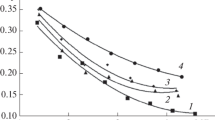Abstract
The effect of a phenolformaldehyde binder and the nature of reinforcing fibers, i.e., polyoxadiazol and carbon fabrics, on the specific features of the friction of polymer composite materials (PCMs) and the formation of their self-lubricating properties is shown. The friction of these PCMs is experimentally studied and an analysis of specific features of this process is carried out based on the first formulated general principle of the structure of a friction surface of these PCMs that implies the rigid fixation of fibers in the structure of a fabric. The effect of properties of the fibers and binder on this process is established.
Similar content being viewed by others
References
Belyi, V.A., Sviridenok, A.I., Petrokovets, M.I., and Savkin, V.G., Trenie i iznos materialov na osnove polimerov, (Friction and Wear of Polymer-Based Materials), Minsk: Nauka i Tekhnika, 1976.
Yuqin, T. and Junlong, H., The tribological performance of Kevlar fiber reinforced polyamide 6 composites, Proc. 2nd Int. Conf. on Materials, Mechatronics and Automation, Lecture Notes in Information Technology, 2012, vol. 15, pp. 109–112.
Li, J., The effect of Kevlar pulp content on mechanical and tribological properties of thermoplastic polyimide composites, J. Reinforced Plastics Composites, 2010, vol. 29, pp. 1601–1608.
Dapeng, G., Yulin, Y., Xiaowen, Q., Wei, D., and Lei, S., Influence of weave structures on the tribological properties of hybrid Kevlar/PTFE fabric composites, Chin. J. Mech. Eng., 2012, vol. 25, pp. 1044–1051.
Drozdov, Yu.N., Nadein, V.A., and Puchkov, V.N., Determination of connection between earthquake parameters and tribological characteristics of friction pendular bearings (seismic insulators), Vestnik Mashinostr., 2007, no. 4, pp. 23–30.
Anisimov, A.V., Bakhareva, V.E., Blyshko, I.V., Ginzburg, B.M., Kirik, E.V., and Tochil’nikov, D.G., Chatacteristics of organoplasics based on phenol matrix and oxalon fiber, Voprosy Materialoved., 2006, vol. 46, pp. 113–118.
Kaznacheev, E.G., Zayats, A.M., Lisyakova, G.V., Chukalovskii, P.A., and Shubin, V.B., Increasing of durability of sliding bearings of rolling mill, Stal, 1995, no. 1, pp. 39–40.
Korshak, V.V., Gribova, I.A., Krasnov, A.P., Mamatsashvili, G.V, Dzhashiashvili, T.K., and Lioznov, B.S., Thermal and frictional properties of reinforced systems based on materials from polyheteroarilenes, Trenie Iznos, 1984, vol. 5, no. 6, pp. 965–971.
Bakhareva, V.E. and Nikolaev, G.I., Sovremennye mashinostroitel’nye materialy. Nemetallicheskie materialy (Contemporary Machine-Building Materials. Nonmetallic Materials), St. Petersburg: NPO Professional, 2012.
Krasnov, A.P., Timofeev, V.A., Afonicheva, O.V., Buyaev, D.I., Chukalovskii, P.A., and Kuznetsov, V.V., Role of tribochemical active connectives in formation of new reinforced antifriction wear-resistant material, Voprosy Materialoved, 2006, vol. 46, no. 2, pp. 105–112.
Korshak, V.V., Gribova, I.A., Krasnov, A.P., and Mamatsashvili, G.V., Tribochemical transformation and wear resistance of materials based on the crosslinked polymers, in Evrotrib-81, Warshawa, 1981, vol. 1, pp. 189–197.
Krasnov, A.P., Afonicheva, O.V., Chukalovskii, P.A., Bychkov, R.A., Mit’, V.A., and Timofeev, V.A., Thermofrictional stability of tribochemically self-organized and tribostable polymers and polymer systems, Proc. YaROFRI-2003, Yaroslavl, 2003.
Krasnov, A.P., Rashkovan, I.A., and Kazakov, M.E., Effect of antifriction characteristics of carbon fibers on the properties of filled thermoplasts, Vestnik Mashinostr., 2002, no. 12, pp. 25–28.
Korshak, V.V., Gribova, I.A., Krasnov, A.P., Pavlova, S.S.A., Slonimskii, G.L., and Askadskii, A.A., Kinetic composition of polyheteroarilene link and their wear-resistance, Doklady Akad. Nauk SSSR, 1985, vol. 282, no. 3, pp. 654–659.
Author information
Authors and Affiliations
Corresponding author
Additional information
Original Russian Text © A.S. Yudin, D.I. Buyaev, O.V. Afonicheva, I.G. Goryacheva, A.P. Krasnov, 2013, published in Trenie i Iznos, 2013, Vol. 34, No. 4, pp. 327–336.
About this article
Cite this article
Yudin, A.S., Buyaev, D.I., Afonicheva, O.V. et al. Friction of self-lubricating polymer composites reinforced by heat-resistant fabrics. J. Frict. Wear 34, 245–252 (2013). https://doi.org/10.3103/S1068366613040120
Received:
Published:
Issue Date:
DOI: https://doi.org/10.3103/S1068366613040120



